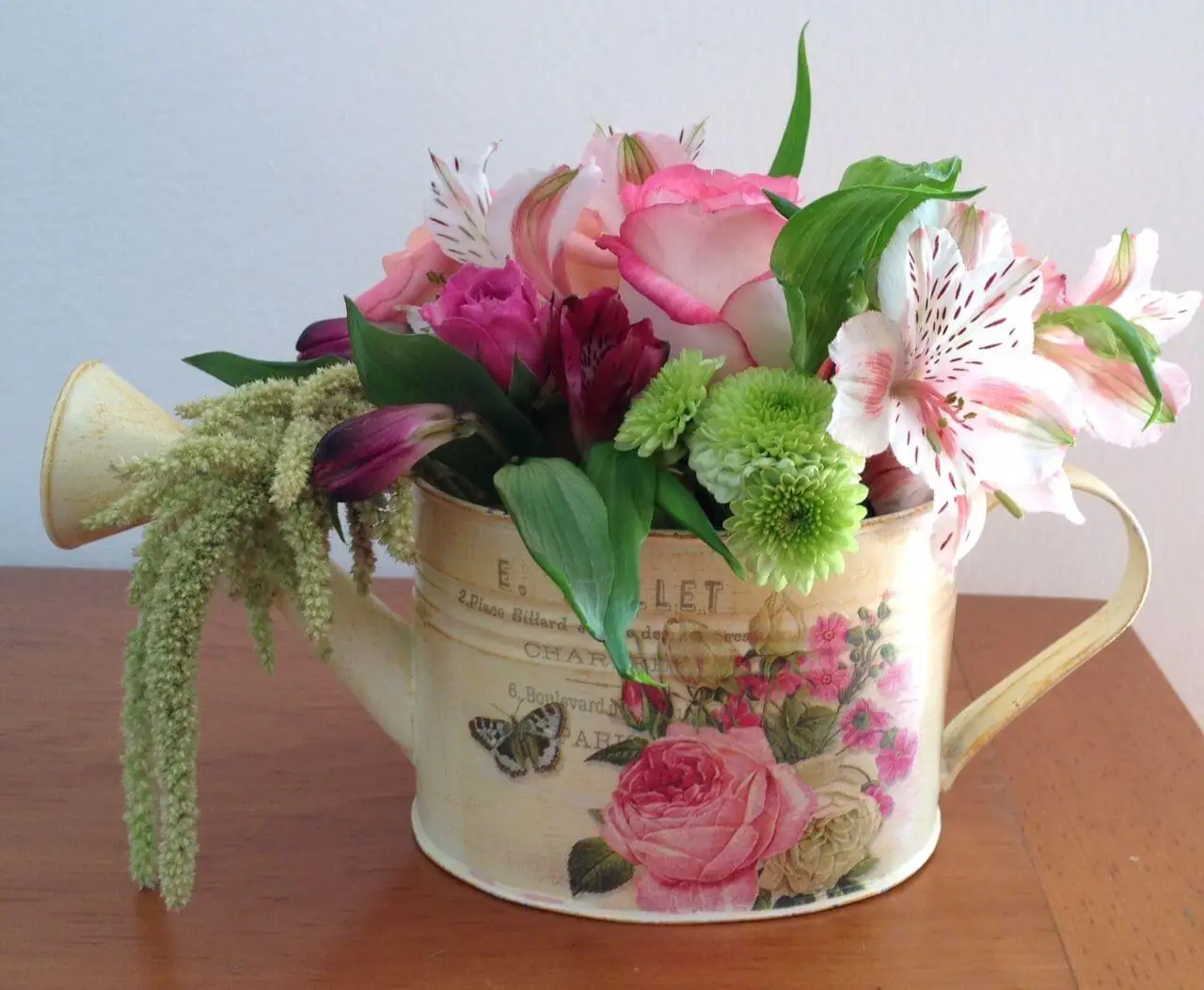9 Tricks to Preserve Cut Flowers for a Longer Time

Freshly cut flowers convey sweetness, beauty, and positive energy, which is why it’s important to preserve their life as long as possible. But prolonging the existence of these plants is complicated when they’re not planted.
Pulling the flowers out of the ground accelerates their aging, which becomes evident through brown tones, warning that they will soon wither. Since they’re ornamental plants, it’s not enough just to soak the stems in water. It’s also necessary to put into practice some tricks that extend the life of your cut flowers.
Why do cut flowers wilt faster?
The newsletter Disseminating Leaves attributes the wilting condition of the flowers to bacteria. Research claims that these microorganisms penetrate plant tissues to infect them.
The publication explains that certain microbes attack the subway organs of plants or the aerial part. Meanwhile, the consequence of bacterial diseases on flowers is wilting.
Depending on the species, some last fresh longer. Bouquets assembled with specimens cut from a garden can last a maximum of 5 weeks, provided they receive the proper care that increases their longevity.
Among the flowers that survive more days in vases are the following:
- Calla lilies
- Zinnias
- Carnations
- Gladiolas
- Chrysanthemums
We think you may also enjoy reading this article: A Man Plants 1000s of Flowers for Blind Wife in Act of Love
Considerations to preserve flowers longer
There are basic rules that help extend the life of flowers inside a vase; one of them is to disinfect the container. To do this, you can fill it with hot water, add a little bleach, and let the mixture work. After an hour, wash it with soap and water.
You should also learn about the species to which the flowers belong so that you know which ones to combine. Some plants release harmful alkaloids, such as liquorine, so it’s best to separate by specimens so as not to dry them out.
As for the water, a couple of days is the maximum for replacement. When changing the hydration, wash and dry the vase before reintroducing the bouquet.
Do not exhibit the flowers next to the window, because direct sunlight depresses them prematurely. A cool place is preferable that’s also away from drafts or heating appliances.

The best tricks to preserve cut flowers longer
If you want to preserve cut flowers longer, select buds that are just beginning to open, those that show the greenest leaves, and those that have firm and colorful petals. Use the tips to extend their freshness with the best specimens in your garden.
1. Feed them with sugar
A spoonful of white sugar feeds the cut flowers.
This ingredient gives plants the nutrients they demand when they leave the soil. Just add two tablespoons of sugar to the water in the vase, and you will notice the vigor of the floral arrangement return.
2. Refrigerate your flower
When they’re bulbous species like tulips or roses, cold water is especially good for them. Florists agree that taking freshly cut bouquets to the refrigerator triples the life of the flowers.
Before placing them in a container, it’s recommended that they spend at least 6 hours in refrigeration. Low temperatures slow down the loss of liquid, favor blooming, and make them need less water.
3. Choose a good vase
Spacious vases help to keep the stems from being too crowded and allow air to circulate among the bouquet. Be careful not to overload the container.
If you have many flowers, divide them into several vases.
On the other hand, the material of manufacture of the vases is fundamental to extend the duration of the arrangement. Glass or crystal are good alternatives, but silver vases preserve flowers longer.
In fact, a section of Nursing magazine comments that silver is a natural biocide, so it destroys microbes. The publication also says that silver prevents water spoilage as an antimicrobial agent.
4. Pour in a bit of chlorine
Chlorine (Cl) exerts an activity related to photosynthesis and is key in cell turgor. The agricultural analysis laboratory Fertilab points out that this chemical element functions as an essential micronutrient for plants.
Deficiency or excess of Cl manifests itself in wilting as transpiration is affected and becomes chlorosis. Appropriate is ¼ teaspoon per liter of water.
5. Add some vodka
A splash of vodka in flower water slows natural ethylene production. In fact, the Universidad Nacional del Centro de la Provincia de Buenos Aires explains that ethylene is a gaseous hormone synthesized by all plant organs, the generation of which increases naturally during leaf separation and senescence or floral aging.
6. Dilute some aspirin
Acetylsalicylic acid or aspirin has among its components sodium carbonate, a mineral salt suitable for extending the life of flowers. A study published in the Revista Fitotecnia Mexicana showed that certain types of salt preserve water relations and the function of conductive tissues, significantly favoring the flowers’ life in vases.
According to these arguments, pulverize two tablets of aspirin and dilute them in lukewarm water. After the mixture cools, add it to the container of fresh flowers.

7. Nourish your cut flowers with some soda
Sodas containing high levels of sugar nourish cut stems; they also lower the pH of the water due to the degree of industrial acidity. To extend the vitality of the flowers, add a little soda to the water in the vase. Preferably, use beverages that don’t stain the water brown.
8. Disinfect with some vinegar
Vinegar is linked to inhibiting bacterial growth. The main constituent of this substance is acetic acid, and its use is common in disinfection protocols, according to a paper in the Ibero-American Pedagogy Network Magazine.
Another scientific research related to the health area revealed that exposure to vinegar for 20 minutes reduces live bacteria. To preserve cut flowers, add two teaspoons of vinegar per liter of water. This cocktail disinfects the water, frees it from bacterial growth, and lengthens floral freshness.
9. Prepare a revitalizer
Mix some vinegar, sugar, and warm water.
These invigorating solutions are ideal remedies for the smoothness of the flowers. This preparation is added to the water in the vase to nourish the plant and prevent bacteria.
Like this article? You may also like to read: 5 Different Ways to Make Flowers with Decorative Materials
The importance of cutting to preserve flowers longer
The way you cut the flowers has a lot to do with how long they last. It’s best to do it in the morning, because there’s less heat, and that is when flowers are more loaded with carbohydrates.
Cut the stems diagonally so that they can absorb liquids without any difficulty. As soon as you prune them, put the flowers in a jar with water so they continue to feed.
Finally, it’s important to note that the conservation of fresh flowers is based on preventing diseases. To do this, it’s pertinent to remove the emerging leaves at the end of the stem, as they tend to get damaged faster and accumulate bacteria.
All cited sources were thoroughly reviewed by our team to ensure their quality, reliability, currency, and validity. The bibliography of this article was considered reliable and of academic or scientific accuracy.
- Alia Tejacal I, Juárez López P, Leana Rojas I, Palacios Sosa A, Pérez Arias G, Valdez Aguilar L. Aplicación de sales minerales para la conservación de flores cortadas de Lisianthus. Revista Fitotecnia Mexicana. Vol. 44. Núm. 3. pp. 417-476. México; 2021. https://revistafitotecniamexicana.org/documentos/44-3/21a.pdf
- Aspirina 500 mg comprimidos efervescentes. Agencia Española de Medicamentos y Productos Sanitarios. España; 2022. https://cima.aemps.es/cima/dochtml/p/67268/Prospecto_67268.html#:~:text=Composici%C3%B3n%20de%20Aspirina,c%C3%ADtrico%20y%20carbonato%20de%20sodio.
- Cáceres Espitia J, Caycedo Lozano L, Trujillo Suárez D. Efecto bactericida del ácido acético presente en el vinagre, una alternativa a desinfectantes sintéticos o químicos. Revisión sistemática. Revista Red Iberoamericana de Pedagogía. Colombia, 2021. https://revista.redipe.org/index.php/1/article/view/1653/1563
- Chindamo M, Luján Basile S, Manfreda V, Ríssola M. Efectos de la hormona vegetal etileno en diversas especies vegetales. Universidad Nacional del Centro de la Provincia de Buenos Aires. Argentina; 2016. https://www.unicen.edu.ar/content/efectos-de-la-hormona-vegetal-etileno-en-diversas-especies-vegetales#:~:text=El%20etileno%20(C2H4.PM%3A,durante%20la%20maduraci%C3%B3n%20del%20fruto.
- Comportamiento del cloro en las plantas y suelo. Fertilab. México. https://www.fertilab.com.mx/Sitio/notas/Comportamiento%20del%20Cloro%20en%20Suelos%20y%20Planta.pdf
- Moronta F. Descubren accidentalmente que el vinagre mata a las bacterias que causan tuberculosis y lepra. Latin American Science. 2015. http://latinamericanscience.org/spanish/2015/12/descubren-accidentalmente-que-el-vinagre-mata-a-las-bacterias-que-causan-tuberculosis-y-lepra/
- Verdeguer Monge A. Daños causados en las plantas ornamentales por bacterias, virus y microplasmas. Hojas divulgadoras. Núm. 10. España. https://www.mapa.gob.es/ministerio/pags/biblioteca/hojas/hd_1985_10.pdf
- Williams V. Plata a nanoescala para el control de infecciones. Nursing edición española. Vol. 32. Núm. 1. pp. 59-60. España; 2015. https://www.elsevier.es/es-revista-nursing-20-articulo-plata-nanoescala-el-control-infecciones-S021253821500031X
This text is provided for informational purposes only and does not replace consultation with a professional. If in doubt, consult your specialist.








